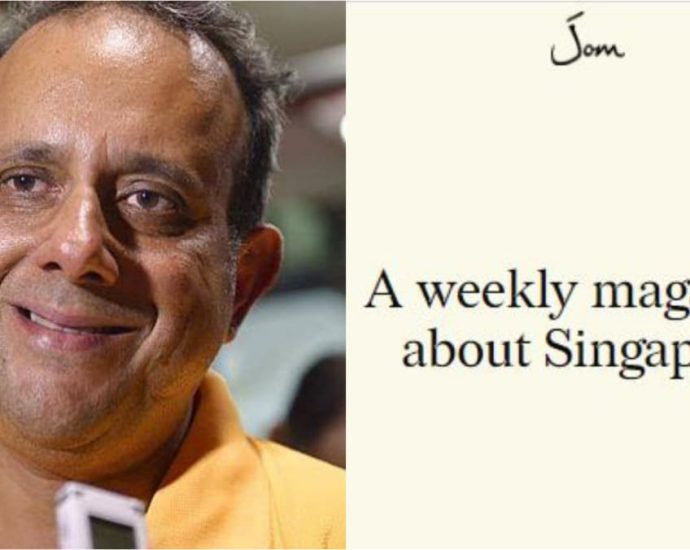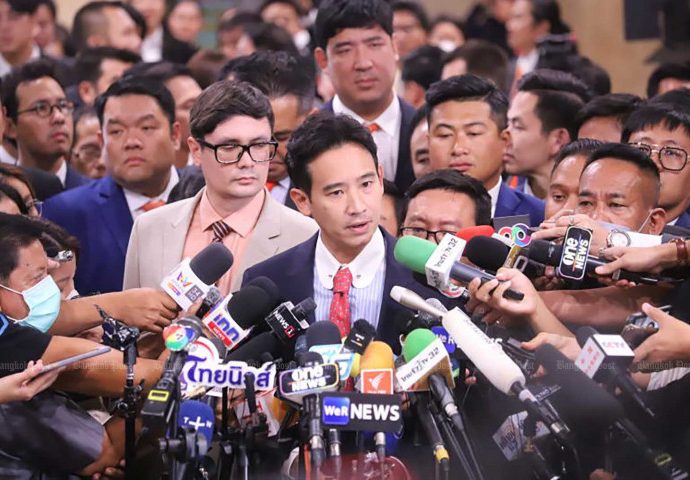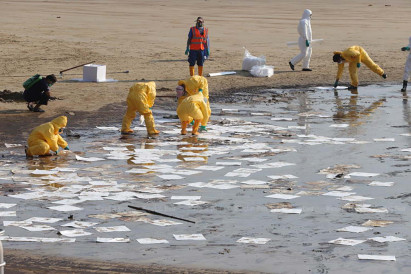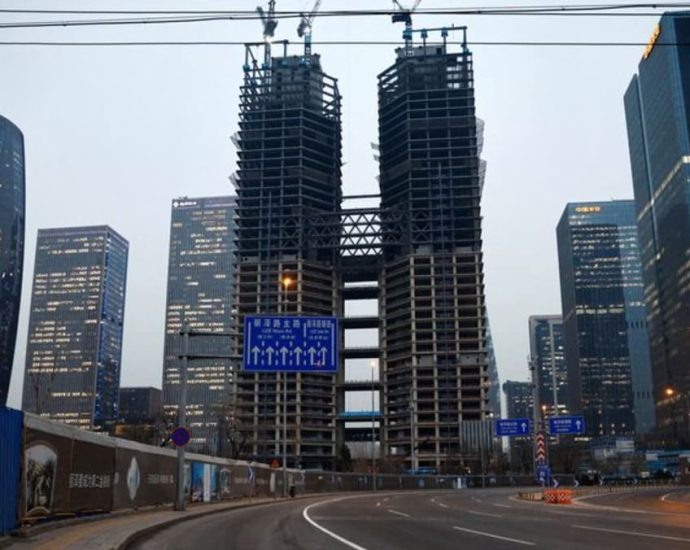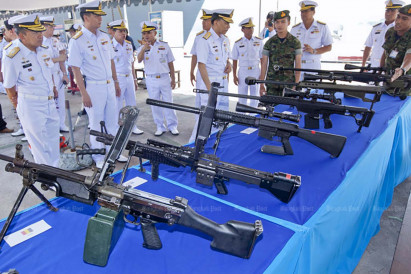US envoy John Kerry heads to China to restart climate talks
BEIJING: US climate envoy John Kerry will head to China on Sunday (Jul 16) to meet with his counterpart Xie Zhenhua and restart stalled talks between the world’s two biggest emitters of planet-warming gases. Kerry’s trip to China – his third as President Joe Biden’s climate emissary – follows weeksContinue Reading
POFMA orders issued to Kenneth Jeyaretnam, online publication Jom over Ridout Road articles
CORRECTION DIRECTIONS TO JOM In a separate press release, MinLaw and the Ministry of Communications and Information (MCI) said Mr Tong and Minister for Communications and Information Josephine Teo have issued correction directions to online publication Jom. According to its website, Jom is a weekly magazine about Singapore. Its co-foundersContinue Reading
Thais want repeated re-nominations of Pita until he’s endorsed: poll

More than 43% of Thais said Pita Limjaroenrat, the sole prime ministerial candidate of the Move Forward Party, should be re-nominated repeatedly until he is finally endorsed if he failed in the first round of vote in parliament, according to an opinion survey by the National Institute of Development Administration, or Nida Poll.
The poll was conducted by telephone interviews with 1,310 people on July 11-12, before parliament convened on July 13 to select the prime minister when Mr Pita was nominated for the post of prime minister. He needed at least 375 votes from the 500 elected House members and the 250 military-appointed senators but managed to get only 324.
Asked what should happen if Mr Pita failed to get the needed votes in the first round, the answers were:
• 43.21% said Mr Pita should be re-nominated repeatedly until he finally gets enough votes
• 20.69% said he should be re-nominated only once or twice
• 12.98% said the Move Forward Party should back down from some policies opposed by senators
• 7.94% said the Pheu Thai Party, which came second in terms of MP numbers, should be immediately allowed to lead the formation of a government
• 4.88% said the Move Forward Party should invite other parties in the former government bloc to join the eight-party alliance to increase support votes
• 2.67% said there should be protest rallies to apply pressure on senators to vote for Mr Pita
• 2.52% said the Pheu Thai Party should immediately take over the Move Forward Party in forming a government
• 2.29% said the Move Forward Party should immediately announce to take the opposition role
• 2.06% said the Pheu Thai Party should immediately form a new alliance to form a government
• 0.76% had no answer or were not interested
Asked who they thought stands a good chance of being nominated for the prime minister’s post if Mr Pita failed to get enough votes, the answers were:
• 38.55% mentioned Paetongtarn Shinawatra of the Pheu Thai Party
• 35.04% Srettha Thavisin of the Pheu Thai Party
• 6.79% Gen Prayut Chan-o-cha of the United Thai Nation Party
• 5.42% Gen Prawit Wongsuwon of the Palang Pracharath Party
• 4.27% Anutin Charnvirakul of the Bhumjaithai Party
• 1.45% Jurin Laksanawisit of the Democrat Party
• 1.07% Pirapan Salirathavibhaga of the United Thai Nation Party
• 1.76% combined mentioned Chaikasem Nitisiri of the Pheu Thai Party and Khunying Sudarat and Sita Divari of the Thai Sang Thai Party.
The rest, 5.65%, had no answer or were not interested.
Most people for repeated re-nominations of Pita until he is endorsed: Nida Poll

Most people said Pita Limjaroenrat, the sole prime ministerial candidate of the Move Forward Party, should be re-nominated repeatedly until he is finally endorsed if he failed in the first round of vote in parliament, according to an opinion survey by the National Institute of Development Administration, or Nida Poll.
The poll was conducted by telephone interviews with 1,310 people on July 11-12, before parliament convened on July 13 to select the prime minister when Mr Pita was nominated for the post of prime minister. He needed at least 375 votes of endorsement but managed to get only 324.
Asked what if Mr Pita failed to get the needed votes in the first round, the answers varied:
• 43.21% said Mr Pita should be re-nominated repeatedly until he finally gets enough votes
• 20.69% said he should be re-nominated only once or twice
• 12.98% said the Move Forward Party should back down from some policies disagreed by senators
• 7.94% said the Pheu Thai Party, which came second in terms of MP numbers, should be immediately allowed to lead the formation of a government
• 4.88% said the Move Forward Party should invite other parties in the former government bloc to join the eight-party alliance to increase support votes
• 2.67% said there should be protest rallies to apply pressure on senators to vote for Mr Pita
• 2.52% said the Pheu Thai Party should immediately take over the Move Forward Party in forming a government
• 2.29% said the Move Forward Party should immediately announce to take the opposition role
• 2.06% said the Pheu Thai Party should immediately form a new alliance to form a government
• 0.76% had no answer or were not interested
Asked who they thought stands a good chance of being nominated for the prime minister’s post if Mr Pita failed to get enough votes, the answers:
• 38.55% mentioned Paetongtarn Shinawatra of the Pheu Thai Party
• 35.04% Srettha Thavisin of the Pheu Thai Party
• 6.79% Gen Prayut Chan-o-cha of the United Thai Nation Party
• 5.42% Gen Prawit Wongsuwon of the Palang Pracharath Party
• 4.27% Anutin Charnvirakul of the Bhumjaithai Party
• 1.45% Jurin Laksanawisit of the Democrat Party
• 1.07% Pirapan Salirathavibhaga of the United Thai Nation Party
• 1.76% combined mentioned Chaikasem Nitisiri of the Pheu Thai Party and Khunying Sudarat and Sita Divari of the Thai Sang Thai Party.
The rest, 5.65%, had no answer or were not interested.
CPTPP: UK agrees to join Asia’s trade club but what is it?
 Getty Images
Getty ImagesThe UK has signed a deal to join a trade pact with several countries in Asia and the Pacific, including Japan and Australia.
The name of this pact – CPTPP – is an unwieldy mouthful, but it’s also a new club of 500 million people the UK will be able to access.
So what does it mean for the fortunes of businesses and households?
What is the CPTPP?
The Comprehensive and Progressive Agreement for Trans-Pacific Partnership (CPTPP) is a trade agreement between 11 nations: Australia, Brunei, Canada, Chile, Japan, Malaysia, Mexico, New Zealand, Peru, Singapore and Vietnam.
Those founding members signed the Pacific trade pact in March 2018.
Between them, they generate 13% of the world’s income.
The UK is the first non-founding country to join, and will be its second biggest economy after Japan. It takes the value of the new grouping to £11 trillion.
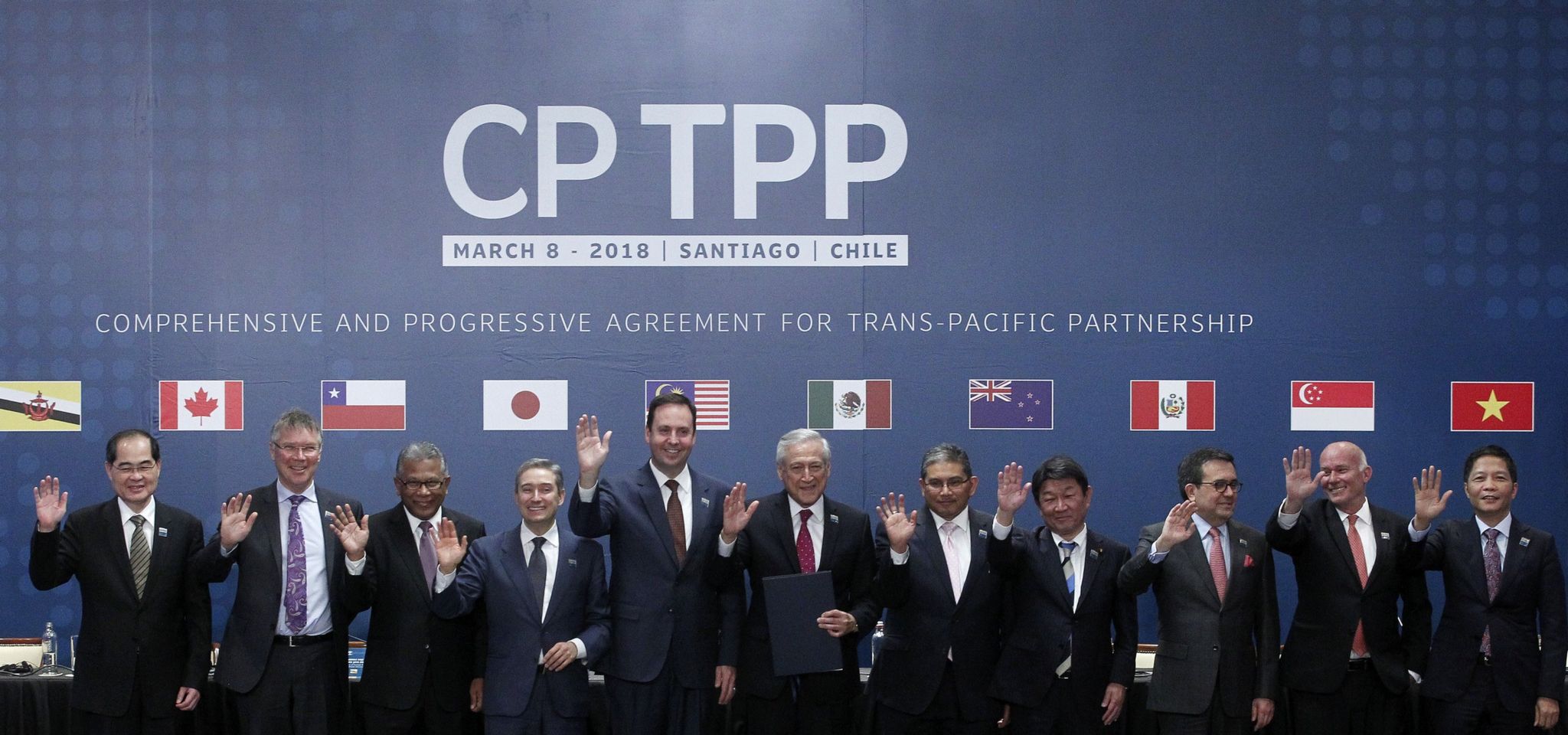
What’s in it for the UK?
The short-term gains are marginal.
The UK already had deals with the majority of these nations as part of its EU membership which have been carried over.
Since Brexit, the UK has added Australia and New Zealand to its trade deal tally.
It was just Brunei and Malaysia left that the UK didn’t have a deal with and between them those two account for less than 0.5% of the total of UK trade.
Even with some changes to the trading arrangements with other countries, the gains from the expanded accord is expected to be fairly small – around 0.08% of GDP over 10 years, according to the government’s best stab at an estimate.
However the Business and Trade Secretary likens CPTPP to a start-up, indicating the estimates doesn’t account for the fact that some members – for example, Vietnam – are rapidly growing in importance in global trade.
Even so, by contrast, leaving the EU, the government’s independent forecasters reckon, will have reduced the UK’s growth by far more – perhaps 4% of our income.
In total, the CPTPP accounted for 8% of UK exports in 2019 – less than we sold to Germany.
What changes?
The key perk is greater access to each other’s markets, and a pledge to eliminate or reduce 95% of import charges or tariffs.
But some are kept to protect sensitive domestic areas, such as Japan’s rice farming industry.
Also, manufacturers that get components from lots of different places can claim their products qualify for preferential treatment.
That means they can tick the so-called “rules of origin” box, as long as 70% of those components come from any of the participating countries.
The provisions could help UK producers of items such as machinery and medicines – our most valuable exports to those nations – by reducing their costs and allowing them to expand their supply chains across the constituent countries.
Away from trade, membership means investors from CPTPP countries get the same treatment as domestic firms when they put money into projects taking place in other member states, which could benefit UK firms.
In 2017, the CPTPP nations accounted for about £1 in every £12 of foreign investment in the UK, and the same going the other way – supporting business and jobs.
In return, countries must co-operate on regulations, such as food standards.
However, unlike the European Union, the CPTPP is neither a single market nor a customs union.
So countries are not required to have identical regulations and standards.
And countries can strike their own trade deals with others, as the UK has with the EU – although membership of the CPTPP would not be consistent with re-joining the EU itself.
What are the concerns?
In short, what has the UK had to agree to as the price of admission?
Some, including members of a House of Lords committee want to know how the UK intends, for example, to ensure environmental and animal welfare standards will be met.
The government has pointed out that CPTPP allows members to set their own levels of protection and it wouldn’t compromise the UK’s standards.
As part of the agreement, the UK will grant Canadian farmers more access to UK markets – but hormone-treated meat will still be banned.
And it is conceding to lower tariffs on imports of Malaysian palm oil – which has been blamed for aiding deforestation. Those charges currently can be up to 12%.
Trade unions have voiced concerns that plans to encourage more investment could allow multinational companies to legally challenge British policies – although trade experts say this capacity exists in other trade deals, and hasn’t ever been successfully exercised against the government.
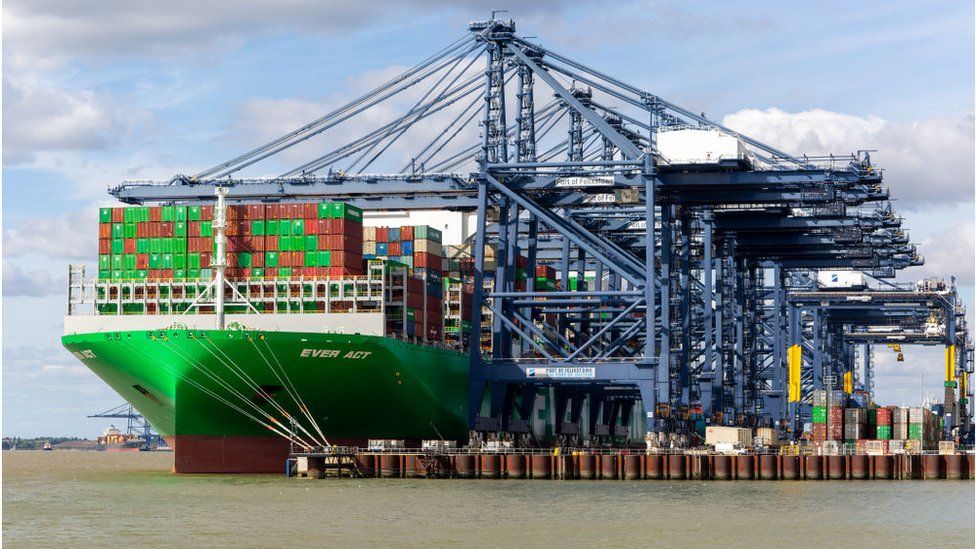
What about the future?
The treaty will be scrutinised and ratified by members before coming into force, which could take at least a year.
It is the partnership’s potential that is key.
The agreement will loosen restrictions on services and digital trade, which matches the UK’s ambitions, and ties it in with some of the faster-growing nations.
But the biggest rewards – and challenges – could occur if others join the club.
China is among those vying to sign up, as is Taiwan.
Could the UK veto China’s membership? Or use its membership to shape China’s access and ambitions?
The real prize would be if the US reverses the decision made by President Trump not to sign up.
America buys about double the amount of UK exports than the current CPTPP nations put together, but membership doesn’t appear to be on President Biden’s to-do list.
At present, membership of the CPTPP is a mainly symbolic win for post-Brexit Britain.
But ultimately it could yield considerable rewards.
Related Topics
22 oil leaks, 507 tonnes of waste in one year

The Ministry of Natural Resources and Environment has reported 22 incidents of oil leaks in the Gulf of Thailand and a total of 507 tonnes of rubbish collected from the seas around the country last year, said deputy government spokeswoman Traisulee Taisaranakul.
Ms Traisulee said the cabinet has acknowledged the report from the ministry offering an overview of the country’s marine environment situation in 24 coastal provinces last year.
Overall, sea water quality was found to be slightly more polluted due to oil spills and garbage dumps from industrial plants. Reports said that 7% of sea water is very clean with 57% rated as clean, 30% moderately clean and 6% polluted.
Ms Traisulee said that there were 22 incidents of oil leaks last year, most of which occurred in Rayong and neighbouring Chon Buri where many industrial plants are located and tourist activities take place.
The ministry also reported that over 507 tonnes of marine garbage and debris were collected from the seas around the country last year. Most were discarded bottles, plastic bags and styrofoam.
Of the 659 sea animals found to have beached last year, 168 had died from ingesting plastic and becoming entangled with drifting rubbish.
The ministry also reported that 823 km of the country’s 3,151 km coastline is eroded. Of the eroded coasts, 753 km of coastline has been repaired by constructing barriers and sand fences, said Ms Traisulee. She added the coral reef situation in Thailand improved last year compared to the previous year.
The country has 149,182 rai of coral reef. The ministry said 53% of the reefs are in good condition, 22% in moderately good condition while some of the remaining 25% have been slightly bleached.
Seagrass around the country has expanded by 4% compared to 2021. It was found that of the 103,580 rai of seagrass nationwide, 25% were in good condition, 36% in moderately good condition and the remaining 35% slightly good condition.
Also, the country has 1.73 million rai of mangrove forests which are found to be most densely-grown in the southern provinces along the lower Andaman coast. As for the beach forests, there are 47,149 rai across 18 provinces. Few expanses of such forests remain due to a lack of conservation efforts and heavy tourism. Turning to rare marine animals, Ms Traisulee said 273 dugongs and 2,310 dolphins and whales were found in the country’s seas. Sea turtles were reported to have laid eggs in 604 nests.
Thai brides flee as sweet talk sours

victims say deals gateway to abuse
Women hired to marry Chinese men risk breaking the law both in China and Thailand, warned the police on Saturday.
The warning came after the Anti-Trafficking in Persons Division (ATPD) found that a Thai woman in Udon Thani, who endured three years of assault in China, was not the victim of a human trafficking offence.
The woman married a Chinese man of her own free will so it is not a human trafficking case, said ATPD deputy commander Pol Col Surapong Chatsut.
The woman, identified by police as a 31-year-old Nuch, signed a contract with a go-between, legally obliging her to marry a Chinese man to produce a child.
Ms Nuch earlier told police she and three others were tricked into marrying Chinese men.
They were said to be persuaded by a matchmaker, identified as Da, to tie the knot with Chinese men for 100,000-baht dowries with a condition that they get pregnant in the first six months.
However, the victims were said to have stayed in China as servants or even the second wives to their fathers-in-law after the babies were delivered.
Ms Nuch, who is from the province’s Nong Wua So district, first told the media on Thursday about her marriage and the torment she suffered. She said she and three other Thai women were able to leave China and arrived back in Thailand last month thanks to her mother’s help.
Ms Nuch said she married 32-year-old Chinese national Jin Wei Lian less than three days after their matchmaking before moving to China’s Hubei province.
She said she told the matchmaker before meeting her husband that she was unable to bear children, but the marriage went ahead regardless. She was kept in a house and was assaulted by her husband and her mother-in-law for failing to conceive.
She said she was assaulted for three years before she decided to flee to Thailand along with three other women who also reported unhappy and abusive marriages to Chinese partners.
Pol Col Surapong said that to be admissible as a human trafficking offence, the victim must suffer a forcible act. Under the Anti-Trafficking Act 2008, such offence covers prostitution, production and distribution of pornographic materials, slavery, forced recruitment of individuals to work as beggars and forced labour.
“Ms Nuch, on the other hand, contractually consented to marry in exchange for a dowry, which is outside of the act’s coverage,” the ATPD deputy commander said.
The ATPD officers were sent to Udon Thani to investigate similar marriage scams there.
Pol Col Surapong said he was concerned some local women may have signed the marriage contract without a full understanding of the fine print contained in the agreement. Getting help to them will be difficult once they have left the country to live in China.
“This issue could make some Thai women feel apprehensive about getting into a relationship with foreign nationals,” he added.
More Chinese men were looking outside their country for women to have children with since China lifted its one-child policy, in place from 1980 to 2016, according to Pol Col Surapong.
Meanwhile, Pol Maj Gen Panthana Nuchanart, deputy commissioner of the Immigration Bureau (IB), said strict measures were being launched to deter Chinese criminals from using Thailand as a base to conduct illegal activities.
The measures were also needed to keep out Chinese fugitives planning to enter the kingdom to escape legal charges.
Pol Maj Gen Panthana said being hired to get married and having gone to live in China entails many legal and personal dangers to the women, who also risk breaking the law both in Thailand and China.
Apart from physical abuse, other possible legal violations concern the terms and conditions of the marriage contracts.
The men who came over from China to spend time in Thailand as part of the marriage arrangement must also comply with the Immigration Act, which stipulates they must notify the IB within 24 hours of their arrival.
Pol Maj Gen Panthana attended a conference on combating trans-border crimes between Thailand and China, in Kunming, capital of China’s Yunnan province, from July 8-12.
Participants exchanged information which enabled authorities in both countries to prepare suppression and prevention measures.
Chinese authorities also agreed to share with the IB their database of criminal suspects facing arrest warrants in China, who might be fleeing to Thailand.
China economic data likely to show recovery is fading quickly
Data on Thursday showed China’s exports fell the most in three years in June, slumping a worse-than-expected 12.4 per cent year-on-year, as cooling global demands add more stress on the economy. New home prices were unchanged in June, the weakest result this year, with rises slowing nationwide in continued weaknessContinue Reading
Navy probes ‘stolen’ ammo allegations

The navy has opened an investigation into an ordnance officer believed to be responsible for stealing large quantity of cartridges from its arsenal in Sattahip naval base in Chon Buri, according to navy spokesman Adm Pokkrong Monthatphalin.
He was responding to the popular CSI-LA Facebook page, run by a Thai expatriate in the US, which alleged tens of thousands of M855 and M856 cartridges as well as thousands of 40mm grenade launcher rounds have gone missing from the navy’s warehouse in Sattahip.
The navy chief Adm Choengchai Chomchoengpaet has ordered a probe into the theft which was reported to the Royal Thai Marine Corps (RTMC) on July 5. An inspection of the arsenal is underway at the compound of the Phra Maha Jetsadaratchao naval camp.
Checks found a significant quantity of ammunition missing, Adm Pokkrong said. He did not give a figure.
A separate panel was also launched by the navy chief’s order to look into disciplinary punishment against the ordnance officer who looted the cartridges. Adm Choengchai has insisted that swift action will be taken.
The RTMC also issued an instruction for the closed-circuit television footage at the arsenal to be reviewed and guards on the premises interviewed. It came to the RTMC’s attention that an ordnance officer had let himself in to the warehouse using duplicate keys he had made and taken ammunition on several occasions.
The officer, whose name was not given, has been absent from work since July 6 and could not be contacted.
The warehouse guards are not involved in the theft, said Adm Pokkrong.
The guards said they did not stop the officer from taking the ammunition because they thought it was part of his working routine.
The CSI-LA Facebook page said one source estimated that at least 400,000 cartridges were stolen. The page added it was curious to know why the ammunition disappeared in the wake of clashes in a neighbouring country and at a time when Thailand’s politics was becoming increasingly unstable over the PM vote.
Pavitr Prabhakar, the Indian Spider-Man charming fans worldwide
 Sony Pictures
Sony PicturesAn Indian Spider-Man is making waves this summer as he swings onto screens in a dhoti (sarong-like garment), gold cuffs and an enviable mop of jet black hair, spouting cultural lessons for his guests from across the multiverse.
He appears in Sony Pictures’ Spider-Man: Across the Spider-Verse – which has spent recent weeks breaking box office records in India. It grossed $2.8m (£2.17m) in its opening weekend alone – the highest debut for an animated film in the country.
That might not come as a surprise, given the popularity in India of Spider-Man – one of the few characters from the West’s comic book universe to make an impact in a country where pop culture is largely dominated by the Hindi film industry.
The superhero’s films have been among the top-grossing Hollywood films in India since 2007, spawning numerous local knock-offs. This includes a love song, whose funny lyrics – “Spider-Man, tune churaya mere dil ka chain” (Spider-Man, Spider-Man, you stole my heart) – have earned a cult status in the country.
But the latest film is a lot more special because it features an Indian version of the superhero for the first time ever.
Meet Pavitr Prabhakar, a messy teen who guards the streets of Mumbattan – a mashup of Manhattan and Mumbai. His name is a play on Peter Parker, the teen behind the original Spider-Man mask.
Pavitr is among the five different spider stars – all from alternate realties but connected through their shared powers – who team up with teen hero Miles Morales to stop a wily supervillain.
Pavitr’s depiction has been praised by fans across the world, especially Indians who’ve been won over by his exuberant personality.
Some have fallen in love with the tropical, curvy art-style for the Mumbattan sequence of the film – an homage to the Indrajal Comics from 1970s, an Indian imprint known for publishing stories about the Phantom and Mandrake the Magician in regional languages.
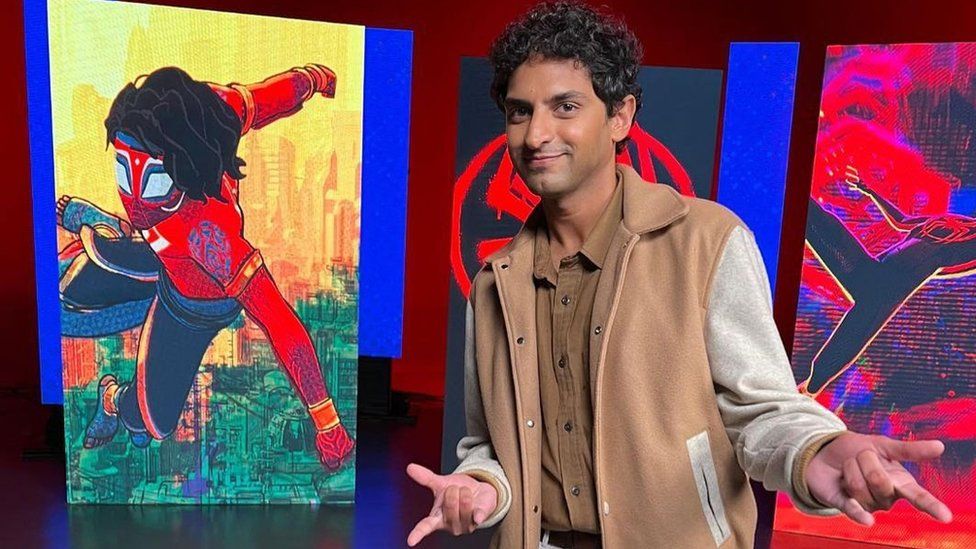
Others have praised the way the film bands together characters of different backgrounds to create a first-of-its-kind multi-ethnic team of superheroes.
“First Marvel gave us first black Spider-Man, Miles Morales and now we have Pavitr. The story is trying to touch on an exciting idea: that anyone can be Spider-Man,” says Mrityunjoy Pal, an ardent comic fan.
While Pavitr is new to many viewers in India and abroad, his origin story goes back decades, a time when the superhero scene in the country was confined to a niche community of comic book enthusiasts.
The character made his first appearance in Spider-Man: India #1 in 2004 – a comic book which sold over a million copies in a run that lasted four issues.
The comic book sticks to Spider-Man’s universal premise of a friendly neighbourhood superhero.
Like any teenage boy with competing priorities, Pavitr struggles to balance homework with his hero work. At school, he is mercilessly bullied – but at night, he transforms into a crime-fighting superhero who swings past skyscrapers with superhuman speed. He dons the mask to protect the one he loves, and for that he must keep his identity a secret.
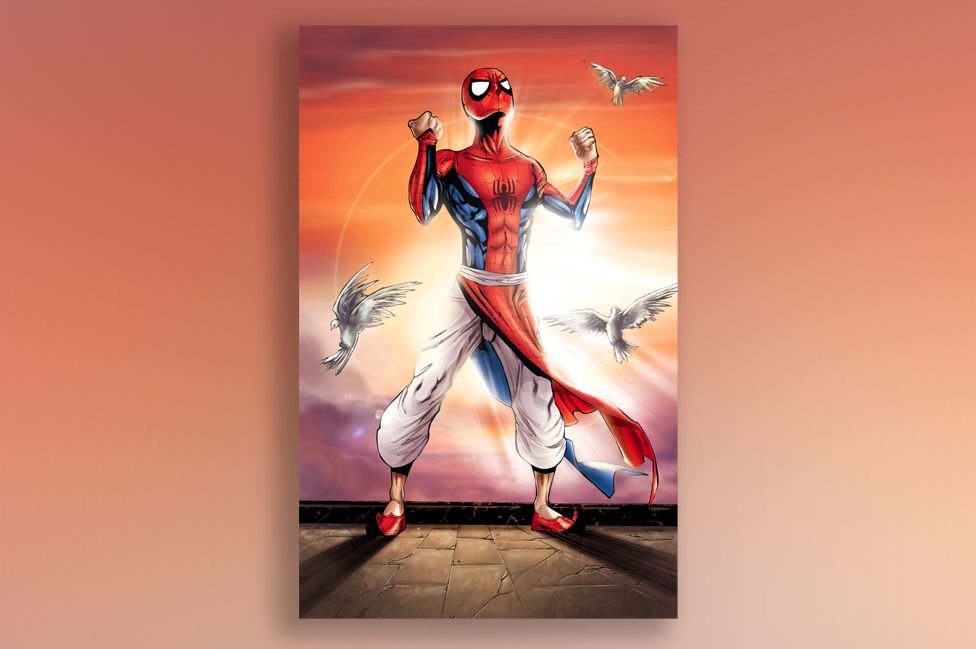
But Pavitr’s story also comes with a special Indian twist. He is a chai-sipping, dhoti-wearing superhero who gets his powers from a yogi – a mystic guru – and not from a radioactive spider bite.
Instead of being smitten with Mary Jane, the girl-next-door, Pavitr has a crush on his classmate Meera Jain. And unlike Peter Parker, who is bullied in school for being a “bookworm”, Pavitr is a scholarship student from a small village who is ridiculed for his appearance.
He is an “Indian Spider-Man” made by Indian creators. That is what Sharad Devarajan and his co-creators Jeevan Kang and Suresh Seetharaman said when they first conceptualised Pavitr in 2003.
“We chose to play on the larger social allegory of having Pavitr be a village boy who feels out of touch with the Mumbai elite because it was reflective of what we saw in 2004 when big cities seemed to be moving at light speed while many of the people in rural India felt completely separated,” Mr Devarajan told the BBC.

The Spider-Verse introduced audiences to a cast of diverse Spider-people from different race and gender backgrounds: Morales, who is of African and Puerto Rican heritage; Miguel O’Hara’s Spider-Man who is of Mexican descent; Jessica Drew, Marvel’s first pregnant superhero; and Hobie Brown’s Spider-Punk who is of African descent.
But back in 2004, reimagining an icon such as Spider-Man was a lot more challenging, especially for an Indian audience who, Mr Devarajan explains, had seen images of the character but did not know his story and had not read any comics about him.
India has always had a vast appetite for comic books – which are a common sight at grocery stores, newspaper sellers and railway platforms. They have been made popular by visual retellings of mythological stories in Amar Chitra Katha, and weekly children’s magazines like Twinkle and Champak.
“There has been a tremendous interest in history and mythology, and most of our comic books and books fall in those two genres,” says Jatin Varma, founder of Comic-Con India.
But the country’s appetite for superheroes is more recent. Some of this could be because the space has traditionally been dominated by heroes of Indian cinema. These films offer a spectacle with bombastic storylines that see male leads dodging bullets, jumping off rooftops and fighting dozens of goons to save the day.
“Our aim was to simply turn an international hero into a local icon,” Mr Devarajan said. “A relatable guy who swings from the Gateway of India over city streets in Mumbai and celebrates Diwali with his aunt.”
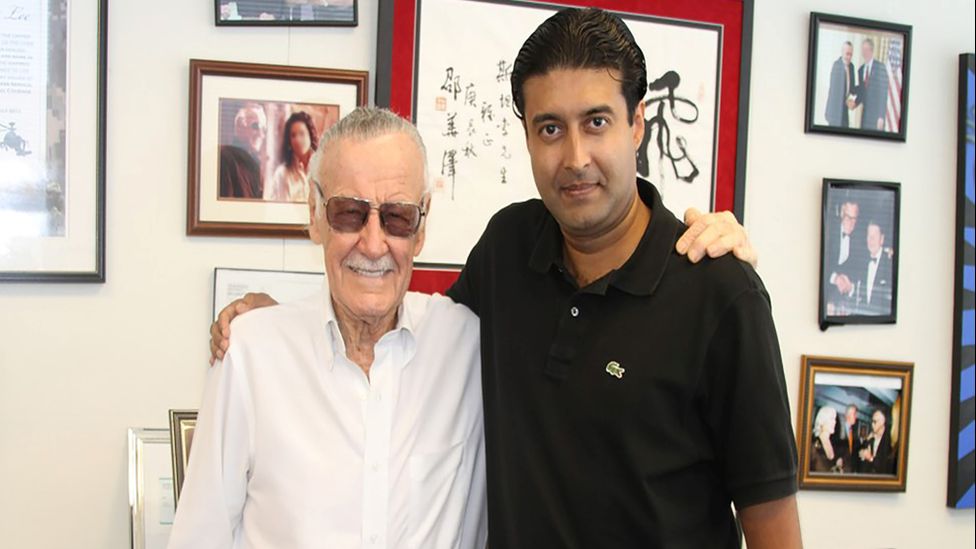
Twenty years on, Pavitr is doing exactly that – and more.
In the film, he ditches the white dhoti for a more stylish blue one – which he pairs with a funky suit decorated with intricate Indian motifs, and a cool hard-part haircut.
Even his character – which in Mr Devarajan’s words “represented the more traditional and simple family value system of Indians” – undergoes certain modifications.
Unlike Miles, who is worn down by the anxiety of his powers, Pavitr is unshakably optimistic as he swings through the chaotic vistas of Mumbattan with cool remove.
His self-assured and confident side drives the plot on several occasions. During a tour of Mumbattan, he says: “This is where the British stole all our stuff.”
He even makes fun of Miles for requesting “chai tea” (which is like saying he’d like a cup of “tea tea”), and quips: “Would I ask you for a coffee-coffee, with room for cream-cream?”
In an interview with Variety magazine, Kemp Power, one of the film’s three directors, said the team “literally re-broke Pavitr’s sequence and reimagined his character” mid-production, after some animators of Indian descent working on the film felt that Pavitr needed to be more authentic.
“It really spoke to the spirit of collaboration on this movie,” he said.
Mr Varma says even though the film caters primarily to an audience outside of India, the cultural elements do not feel lazy or stereotypical. “And the fact that this Indian Spider-Man was part of arguably one of the best Spidey movies, made it even better.”
Mr Devarajan says the film “changed the costume, but the heart, character and unique Indianess of Pavitr remain the same.”
He hopes this is just the beginning for Pavitr’s growth as a character in the Marvel world.
“It only took 20 years for Pavitr to jump from that comic we created and onto the big screen,” he says.
“Hopefully it won’t take another 20 before we see the live action version. India needs its Spider-Man!”


